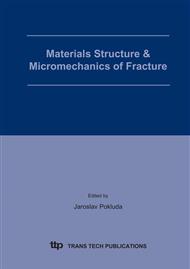p.71
p.77
p.83
p.89
p.95
p.103
p.109
p.115
p.123
The Significance of Plastic Zone Growth under Cyclic Loading and Crack Opening/Closing Model in Fatigue Crack Propagation
Abstract:
Fatigue cracks remain closed at lower loading level during a part of load cycle even though a tension-to-tension loading is applied. The crack closure plays a role to obstruct the generation and growth of compressive plastic zone during unloading. Cyclic plastic work, which corresponds to an irreversible energy consumed in a cracked body is generated ahead of a crack, is required as a fatigue crack driving force. The amout of cyclic plasticity is reduced by a crack closure. The crack opening/closing model based on the Dugdale model under arbitrary stress distributions for a through thickness straight crack is proposed and the fatigue crack growth under various loadings is investigated.
Info:
Periodical:
Pages:
95-102
Citation:
Online since:
April 2005
Authors:
Price:
Сopyright:
© 2005 Trans Tech Publications Ltd. All Rights Reserved
Share:
Citation:


